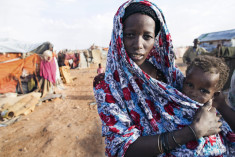-
Driven to Care: Improving Transportation to Reach Maternal Health Care in Conflict Zones
August 20, 2018 By Yuval Cohen How much time passes between a laboring woman’s decision to seek care and her arrival at a health facility? Transportation for emergency obstetric care should be swift and timely, but for many refugees in the world’s conflict zones, it is not.
How much time passes between a laboring woman’s decision to seek care and her arrival at a health facility? Transportation for emergency obstetric care should be swift and timely, but for many refugees in the world’s conflict zones, it is not.An analysis of refugee maternal mortality in 10 countries found that transportation problems contributed to more maternal deaths outside of refugee camps, which tend to have better access to emergency transportation services.

Location Matters
How much time passes between a laboring woman’s decision to seek care and her arrival at a health facility? Transportation for emergency obstetric care should be swift and timely, but for many refugees in the world’s conflict zones, it is not.
An analysis of refugee maternal mortality in 10 countries found that transportation problems contributed to more maternal deaths outside of refugee camps, which tend to have better access to emergency transportation services.
According to the study, “targeted efforts in refugee camps to ensure surveillance of pregnancies by health care staff and provide transportation to maternal health services may have helped to minimize the prevalence of these types of delays.” The proximity of NGO health clinics to refugee camps also lessens the transportation time.
Not all refugee camps are created equal, however. In one refugee camp in Uganda, the UN Office for the Coordination of Humanitarian Affairs reported in 2012, “only one ambulance was available to take women to hospitals if they experienced complications and needed emergency obstetric care.”
Access to transportation also depends on the camp’s security and location. According to a 2010 field report, the refugee camps of Dadaab, Kenya—which today shelter approximately 235,000 Somali refugees—are located in insecure areas. Neither public transportation nor health agency vehicles would run at night to avoid being attacked.
Violence against ambulances and other health vehicles is not unique—in fact, in 2011, the International Committee of the Red Cross reported high rates of attacks on ambulances in Colombia, Iraq, Libya, Mexico, Nepal, the Palestinian territories, and Yemen. Attacks against health vehicles have become more and more common in areas of ongoing conflict, affecting women’s ability to travel to facilities safely.
Mobile Clinics and Mama Taxis
UNFPA and its partners have deployed mobile clinics to areas where women often cannot reach services. UNFPA’s mobile clinics in Greece provide prenatal, postpartum, and reproductive health services, including family planning, to some of the 48,000 refugees living there.
In Myanmar, which has the largest concentration of internally displaced people in Southeast Asia, local physicians and nurses operate temporary and mobile clinics in conflict-torn Rakhine State, bringing reproductive and maternal health services to women and adolescent girls “who did not have the freedom to safely move to stationary or government-run hospitals or clinics,” according to a UNFPA report.
In Dadaab, the UN Refugee Agency (UNHCR) and its partners introduced “mama taxis”—community-run taxis that provide emergency transportation to women in the evenings and at night, when public transportation was unavailable. Mama taxis have also reduced the length of the first delay, as women who use them seek out health services more often, even at night.
In Somali’s refugee camps, “waiting homes” offer a way for pregnant women to remain close to health facilities in the days leading up to their delivery. If they have any complications, appropriate health facilities are easily accessible.
When transportation and referral systems are not available, UNHCR’s Minimum Initial Service Package. mandates that visibly pregnant women and birth attendants should receive clean delivery kits to facilitate safer deliveries in their camps or homes.
Providing safe and accessible transportation systems to women in crisis settings, including refugees and internally displaced people, not only reduces the delays from transportation, but also reduces delays in seeking care. Whether or not a woman seeks care is largely dependent on her expectations. If women expect that they will be able to get to a clinic in a timely fashion, they will be that much quicker to seek care in the first place.
Sources: Guttmacher Institute, International Committee of the Red Cross, Social Science and Medicine Journal, UN Office for the Coordination of Humanitarian Affairs, UN Refugee Agency, United Nations Population Fund
Photo Credit: Jowle camp for the displaced camp in Garowe, September 2013. Photo by Agata Gryzbowska and EU Civil Protection and Humanitarian Aid Operations.
 A Publication of the Stimson Center.
A Publication of the Stimson Center.

 How much time passes between a laboring woman’s decision to seek care and her arrival at a health facility? Transportation for emergency obstetric care should be swift and timely, but for many refugees in the world’s conflict zones, it is not.
How much time passes between a laboring woman’s decision to seek care and her arrival at a health facility? Transportation for emergency obstetric care should be swift and timely, but for many refugees in the world’s conflict zones, it is not.

